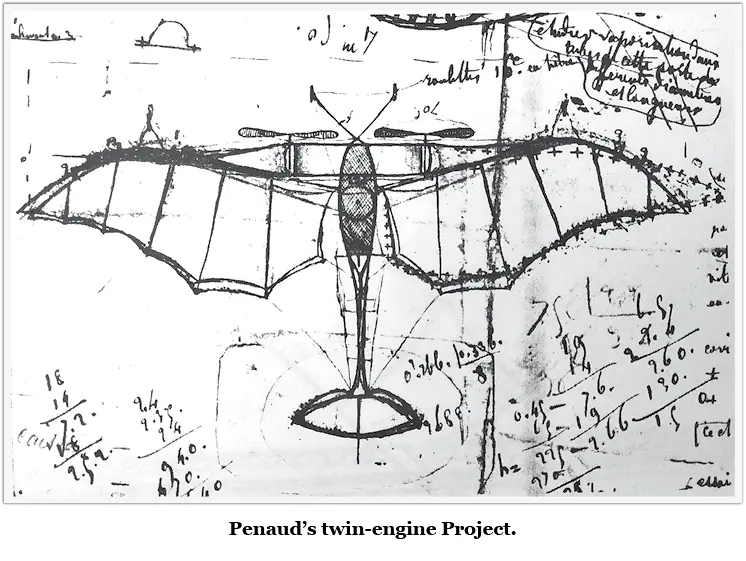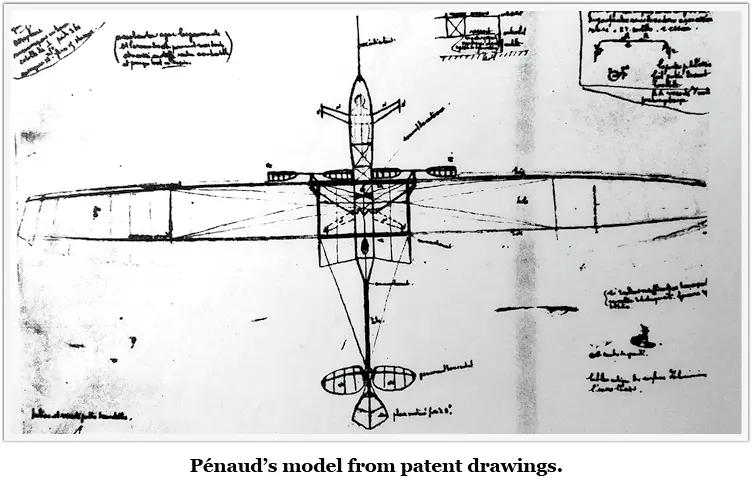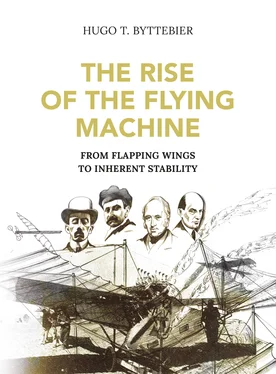Marey showed that a bird’s wing consists of two sections; a central part that provides lift like an aeroplane’s wing, whilst the bird’s wingtips provide thrust, working like propellers. The bird flies because it acquires horizontal speed and not because it flaps its wings up and down. “Translation gives three times as much lift as down beating”, said Marey and he gave the definitive proof by tying a bird with a long string to the ground. As soon as the wire became taut and the bird’s horizontal progress was arrested, the poor animal, for all its frantic flapping, fell to the ground.
The bird’s wingtip was at that time called “aileron” by the French, a word that was to acquire, quite by accident, a completely different meaning in 1908.
Marey was not the first to have discovered the true movement of the bird’s wing because Cayley had already become aware of the bird’s mode of flying in 1808 and several others after him, notably Wenham (as Pénaud was quick to point out). Marey himself became involved in a heated controversy with S. B. Pettigrew, Professor of Anatomy at the University of St Andrews, who had described a similar theory of bird flight a year earlier.
But Marey’s publications received wide publicity, and even inspired the Wright brothers’ 25 years later. Another effect was that several of Pénaud’s fellow members of the Société , among them the president Hureau de Villeneuve, were dedicated to the building of flapping-wing models which were patterned, or so they thought, after birds.
Pénaud thereupon built a flapping-wing model himself, with the tips providing thrust and the central part providing lift, as with a real bird. It was tested in 1872 and an improved model was built in 1874 and, as Charles Dollfus wrote, “a better result with a flapping-wing machine has never been obtained”.
Pénaud’s Master Patent
In spite of the optimal results of his flapping-wing model, Pénaud remained convinced that “Only the aeroplanes give hope for building full-size machines”. But Pénaud remained for the time being alone in his outlook. The Franco-Prussian War of 1870-1871, and the contact which the beleaguered city of Paris had with the outside world by means of balloons, had turned the attention of the aeronautically minded towards the emergence of the dirigible balloon, which was thought to be around the corner.
In 1875, Pénaud published a complete theory of soaring flight that, according to his perception, was only possible because rising currents of air counteracted the downward glide of the bird under the attraction of gravity. He had already remarked on this in an article published in 1871 dealing with the possibility of human flight without power. Soaring was, like the flight of the kite, flying by the power of the sun.
At a Société meeting on 3 December 1875 Pénaud declared: “We know the true theory of flight, the demonstration of it has been done. We have now only to replace the elastics by heat engines of sufficient power and capable of continuous action.”
Pénaud worked hard during the year to arrive at the specifications for a great man-carrying aeroplane. Several sketches of modern-looking aircraft have survived though the definitive choice, for which a patent was applied and granted, was a kind of flying wing, a step away from the planophore concept. He was probably anxious to cover as great a wing area as possible and fought shy of the construction problems related to wings of high aspect ratio.
Pénaud’s patent (No. 111,574) of 16 February 1876, applied for in his name and that of Paul Gauchot (a mechanically minded enthusiast with whom he had become friendly) is generally regarded as describing a typical aeroplane but when the patent is analysed carefully it is clear that what Pénaud had been striving for was a patent for “The Aeroplane” in generic terms.
What is amazing about this patent is the great amount of modern details. It contained two propellers in front, a retractable undercarriage, a cockpit with windshield for the pilot, a simple steering device for control, a vertical fin and rudder at the rear, variable-pitch propellers and much more.
A provision was included for movable wing tips that “by their resistance to the air would make the apparatus turn”. These were visualized as a kind of movable wingtip rudders, not in order to redress the aeroplane when starting an involuntary roll, as Boulton’s patent of 1868 had specified.
Taking off was to be effected by accelerating over the ground and landing was to be in the manner generally used today. He had also been careful to specify that the construction should be of wood or of metal and on the whole tried not to overlook any detail.
Full attention was given to the powerplant, making sure that no existing engine could be used without falling under the specifications of the patent. All the types of steam engine were mentioned and also “all the engines working with gas explosions known today; specially those working with a mixture of air and gas” nor was the use of engines working with a liquid fuel forgotten. One is left wondering how many aircraft builders today would fall under Pénaud’s patent if it were still valid. But the legal year for expiry was 1891 and at that date there were still no aeroplanes flying anywhere.


The Powerplant Takes Shape
In an article published towards the end of 1876, Pénaud stated his belief that sooner or later science would succeed “in creating the light engines that the solution of the problems related to aviation is clamouring for”. It was already 70 years after Cayley had similarly stated his belief that a light power plant could be developed, but there was a sense by 1876 that things were beginning to move towards an effective solution.
In Philadelphia, during the Exhibition held to celebrate the first centennial of the Independence of the United States, George Brayton showed his new hydrocarbon engine that used preliminary compression and liquid fuel. Brayton’s engine ran smoothly, started easily and seemed to be a great improvement over the old Lenoir engines.
The French engineer Eugène Farcot went to Philadelphia and wrote in a letter to Hureau de Villeneuve: “I have found an engine. Is it the engine of the future for aerial navigation? I don’t know but it is nearing the ideal you set out in 1868.”
As it happened, Brayton had come too late because the real “engine of the future” was already up and running.
From the outset of the use of lighting gas, engine builders had felt that a preliminary compression of the inflammable mixture would increase power ratings manifold, but the question of how to do this had remained unsolved? Brayton had cleverly solved the problem by his separate compressed-air reservoir, but he had been forced to introduce a second cylinder and piston to compress the air, adding weight and mechanical complication.
Around 1861, a French engineer, Alphonse Beau de Rochas had come up with on an ingenious idea. To lose a full cycle in the power-producing process by using the working cylinder during a complete revolution of the crankshaft solely for aspiration and compression of the mixture without doing any useful work. It was a clear case of one step back to take two steps forward.
Beau de Rochas never built an engine to test his speculations but the German Nikolaus Otto did, possibly unaware of the Frenchman’s ideas of 15 years before. He did so to such good effect that in May 1876 the first four-stroke internal combustion engine was running and Otto was granted a master patent (DRP No. 532).
Читать дальше














